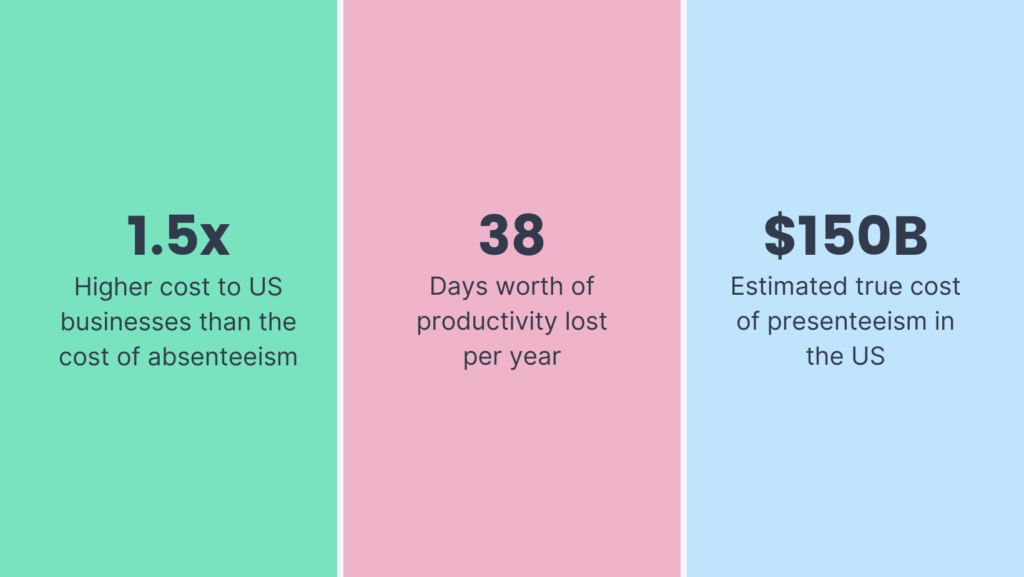April 23, 2024
What is Garden Leave? (Aka Gardening Leave)
Key Takeaways:* Garden Leave, or Gardening Leave, is when an employee leaves their job and is asked to stay a...

What if I told you that your business was losing more productive hours by staff that show up to work than those who don’t?
In most businesses, this is true. It’s a phenomenon known as presenteeism, and it’s one of the most misunderstood concepts in business and HR today.
This article will take a deep dive into the concept, and how to remedy it if this is a problem in your team. We’ll define presenteeism, discuss the fallout of this in terms of productivity and cost, and talk about how to prevent presenteeism in your business.
Trending Article: A Guide to Effective Time Off Tracking for Your Small Business
Presenteeism is when there is a loss in productivity due to employees showing up for work when they’re not at 100%.
It could be due to injury or illness – for example, an employee is sick, and they come to work but can only produce a fraction of their usual work rate.
Another, less understood case, is when employees show up for work when their emotional or mental state is less than 100%. This is also likely to cause a drop in productivity, but it’s not as evident as if they were coughing or limping.
Cases like this are often due to employees working too long without a vacation. It goes hand in hand with burnout, where the employee works too hard for too long, and eventually develops mental fatigue that gets in the way of their being productive.
One of the reasons why presenteeism is such a big issue in today’s workplaces is because it’s so hard to identify.
Compare presenteeism to its sibling, absenteeism. Absenteeism is extremely easy to notice. The employee is either there or they are not. You can count up the days in which the employee has not been in the office (in a physical or virtual sense), and get quite a good estimation on the loss of productivity from their absenteeism.
Yet with presenteeism, you’ve got the image of a model employee. They’re at work every day, sometimes even pushing through an illness or injury. On the face of it, you can’t be sure there’s an issue at all.
Only after digging into it will you figure out there is a loss of productivity. And even then, it’s not as easy as saying the loss of productivity is a clear case of presenteeism.
It takes a deeper understanding of the situation, and often an open, heart-to-heart talk with the employee to diagnose a situation as presenteeism. But it is more prevalent than you’d think. A lot of the people you view as top performers for being in the office everyday without fail could actually be producing more if they took a day or two off more often.
On the surface, it’s easy to be fooled into thinking presenteeism is a minor cost to the business. After all, the lost productivity couldn’t be compared to the employee being absent altogether, right?
Data appears to tell us otherwise.

One study from the Work Foundation found that the cost of presenteeism could make up 1.5 times the cost of sick leave.
A 2019 survey from RAND Europe came to the conclusion that businesses lose over 38 days’ worth of productive time due to presenteeism.
You would be hard-pressed to find a workplace where the average amount of sick leave taken comes anywhere close to those numbers. This can lead us to believe that it’s significantly more damaging when staff come to work when they’re not 100%, compared to simply taking a day or two of sick leave.
The true cost may indeed be even higher. The Harvard Business Review states that certain estimates put the cost of presenteeism to US companies at $150 billion per year.
This goes alongside data from the Journal of the American Medical Association that reports costs to US employers of $35 billion per year for reduced performance due to depression, and $47 billion per year due to conditions such as arthritis, headaches, and back problems.
Even if the actual cost of presenteeism is not quite this bad, there’s no denying it’s a costly problem.
Learn More: dive deeper into the direct and indirect costs of presenteeism, and how we can prevent them.
Presenteeism is, boiled down to its simplest form, a case of performance dropping because employees don’t take enough time off.
But it’s not as easy as just saying that X number of days off prevents it from becoming a problem.
There are a number of underlying reasons why presenteeism happens, and why employees don’t take leave when they need it.
Addressing these problems is a vital step towards reducing the harm presenteeism does to your company.
For a lot of employees, it’s pressure at work that stops them from calling in sick or taking their leave days.
There’s a fear that they’ll fall behind if they take a day off, or that the workload is just too much. The employee feels pressure to come in despite not feeling well, and the result is that this feeling becomes a daily occurrence.
There’s also the feeling that requesting time off, be it sick leave or vacation days, will hurt an employee’s reputation.
A lot of employers create a culture where employees are looked upon in a negative light for taking time off. While this may serve to lower absenteeism, it risks creating an even bigger problem with presenteeism.
Sickness happens, and people need regular breaks from work in order to remain productive and healthy. As an employer, it’s best for you to accept this, and accept your team members’ need for a day off here and there.
Further Reading: all you need to know about Employee Burnout, and how to prevent it in your business.
Many companies simply don’t offer staff enough paid leave days.
This creates an economic headache for workers when they’re feeling unwell. They may recognize that they need a day or two at home, but if faced with the idea of missing pay, most will brave it and come to work anyway.
This is frighteningly common in businesses that don’t offer paid sick leave, or do so at a very low number.
The company may think they’re saving money by not paying staff for their time off, but in reality this is causing a drop in productivity that far outweighs the cost of paid sick leave or vacation days.
Finally, it’s often the case that there’s just too much to go through to ask for time off.
Perhaps it’s a specific person you need to see to request leave, who only shows up in the office for 15 minutes a day.
Or it could be a nerve-wracking grilling you receive every time you call in sick or put in a request for vacation days.
Even with open-minded employers, the anxiety of needing to ask for leave, through an email, face-to-face talk or call, can be enough to prevent some workers from taking their leave days.
This is where a leave tracker like Flamingo helps. It makes requesting leave quick, easy and painless, removing a big barrier to team members getting the time off they need.
For employees that get anxiety over opening a message thread with their boss to ask for a day off (I’m guilty of this), the asynchronous nature of a leave request software is perfect.
Flamingo streamlines leave management, letting you spend less time managing paid time off and more time growing your business
The best approach to reducing levels of presenteeism in your business is to focus on prevention.
You can look for the signs and symptoms of presenteeism and treat them as such, but this is often too late. You’ve already lost productive hours by then, and even worse, there may be irreparable damage done to your employees’ mental or physical health, morale, job satisfaction, and the company culture as a whole.
That’s why you need to focus on creating a culture that reduces presenteeism from the outset. Here are a few tips to help you do just that.
Knowing what presenteeism is, what causes it, and the cost to your business is the first step. Most companies are simply unaware of the scope of the problem, and that it can be more damaging to the business than absenteeism.
You need to make this a core understanding throughout your organization, from employees all the way to upper management.
The biggest step you can take to reducing presenteeism is how you grade performance.
It’s all too common to think of high-performers as those who work long hours, day in and day out. And conversely, those employees who regularly take time off are seen as a problem.
However, attendance doesn’t always correlate with performance. Simply being in the office doesn’t mean someone’s producing results, and often this pressure to be seen ends up hurting things.
Develop performance indicators centered on actual results, and use these KPIs to judge your employees. Realistically, this is all that matters – if your team members meet their benchmarks, it shouldn’t matter whether they have a perfect attendance record or not.
Many companies simply don’t offer enough paid time off in their leave policy, creating a huge problem with employee wellness.
If there’s a financial disincentive to taking a day off, you’re going to see a lot of employees showing up to work when they’re not at 100%. This just snowballs into a bigger and bigger problem.
Before long, the cost of lost productivity, negative company culture, and potential turnover costs add up to significantly more than the cost of giving employees a reasonable number of paid leave days.
You also need to ensure there is no negative sentiment towards people who take time off.
It’s all well and good to allow paid sick leave and a large number of vacation days, but it’s often the case that employees feel they’re looked upon in a negative light when taking their leave.
Create a culture that doesn’t punish or shame people for asking for their time off. You may even need to go a step further and actually encourage people to take leave, as it’s not uncommon for employees to neglect their leave days on their own, even if you’re open and accepting towards time off.
The idea that the best workers are those who work long hours, and make it to work every single day, no matter whether they’re sick, injured, tired or otherwise, is outdated and problematic.
Our understanding of productivity today shows that overwork, especially when someone is not at 100% mentally or physically, is damaging to the business.
It takes time, but we can already see that more organizations are becoming aware of presenteeism, and taking steps to offer improvements to their employees’ health and wellness.
If you’re running a business, take it upon yourself to learn how to avoid losing productive hours due to overwork and lack of available paid leave. Your employees will thank you for it, and so will your bottom line.
Flamingo makes managing your team’s paid time off a breeze.